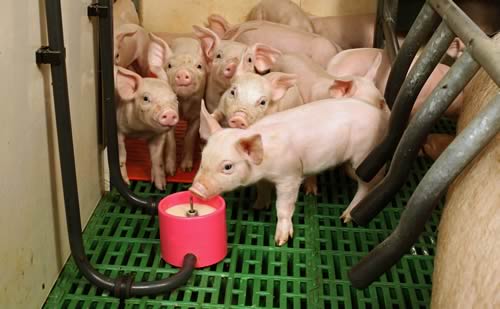| 2018-01-15 |
Supplementing Sows’ Milk in Situ Boosts Litter Weaning Weight
A helping hand by supplementing the sow’s milk in situ has been shown to go a long way in improving piglet performance, according to Yorkshire-based Cargill pig specialist David Hardy.
“The modern sow is capable of producing large litter sizes of 13 or 14 piglets,” he says. “Thanks to advancing genetics, litter size has increased across Europe by an average of 1.5 piglets every five years. Ten years ago, the average litter size in high performing herds was closer to 10 piglets.”
Cargill Rescuecup system in action
However, the sow’s ability to produce milk to feed these larger litters hasn’t improved at the same rate. But, according to Mr Hardy, producers are recognising this deficient and they are using a system of supplementing the sow’s milk ‘in situ’ with impressive results.
“Farmers are acknowledging the new standards that are required in these high production herds,” says David. The modern genotype produces more piglets, but the sow doesn’t give more milk – certainly not enough to fully satisfy the appetite of big litters with 13 or 14 piglets.”
Dutch Research work suggests the sow produces 360 litres of milk on average in a four-week span, whether she has 10 piglets or 14. As a benchmark, its estimated that she can provide for 90kg to 100kg of pigs at four weeks old on milk, dry feed and with no added supplementation.
“But if the litter size is 14 and the piglets are 8kg at weaning at four weeks old, that’s 112kg of ‘piglet’ weight,” he adds. “The sow needs help to support her larger litter.”
David has seen very encouraging results in herds where piglets are supplemented through the Neopigg® RescueCare system. “Results are convincing and consistent with Cargill trial work.
“The RescueCup can meet the deficiency in sow milk production required by larger litters and more,” he adds. “We’ve seen a weaned weight of pig of 150kg at four weeks old where the Neopigg RescueCare system is operating and this is phenomenal. Supplementing the sow’s milk in this way is bringing fantastic results that can easily justify its use.”
The Neopigg RescueCare system works by having a RescueCup® in each farrowing pen, accessible by all piglets. Ad-lib RescueMilk is fed through the cups from day three and this is followed with a Rescue pre-starter feed after five days and fed up to weaning. It avoids relying on foster sows which puts extra pressure on farrowing room management.
Most of the producers that David advises in the north east and across into Cumbria operate indoor housed high-performance herds. “They have embraced genetic progress. Now many are appreciating the need, and benefits to be gained, of using the RescueCup with milk then a pre-starter.”
The recent results speak for themselves, with improved productivity making the investment easy to justify. “Not only are the smaller piglets able to get sufficient feed, but the system has been shown to enhance the appetite of larger piglets in the group. They can reach heavier weaning weights. Remarkably we regularly see individual piglet weaning weights of over 15kg where the full Neopigg RescueCare system is adopted.”
And looking at the costs, Cargill’s UK team has estimated a payback of 2 to 1 where the Neopigg RescueCare system is used through improved productivity and better piglet livability (a greater proportion of weaned piglets per litter) and greater sow efficiency.
Two years after its introduction, there are now around 12,000 sows on the Neopigg RescueCare system in the UK, which is approximately 5.5% of the sow population. “The results are good, and I am seeing a growing interest in the system among progressive pig farmers,” adds David. “It’s a valuable management tool that farmers can use to realise the genetic potential of their herd – and most importantly, no piglet goes hungry.”


